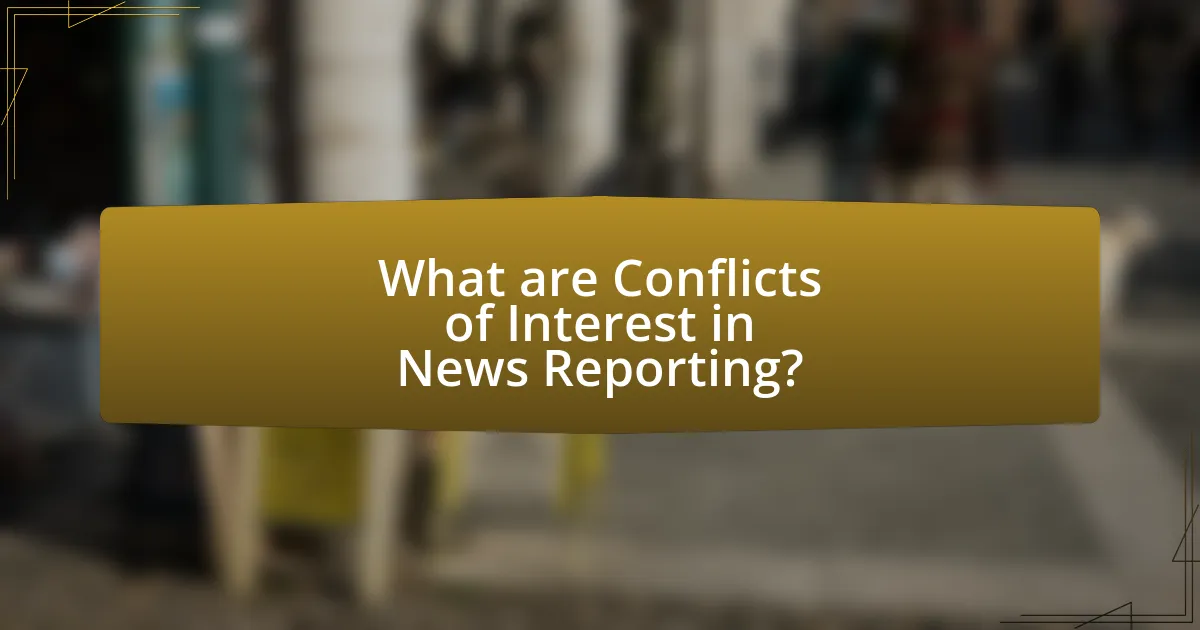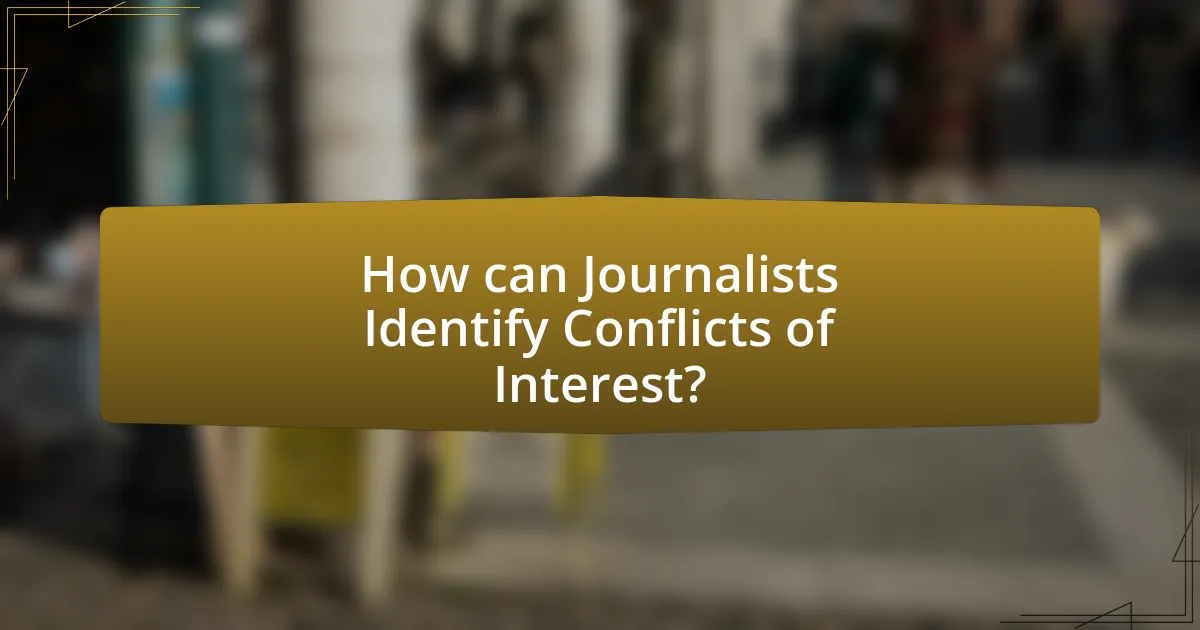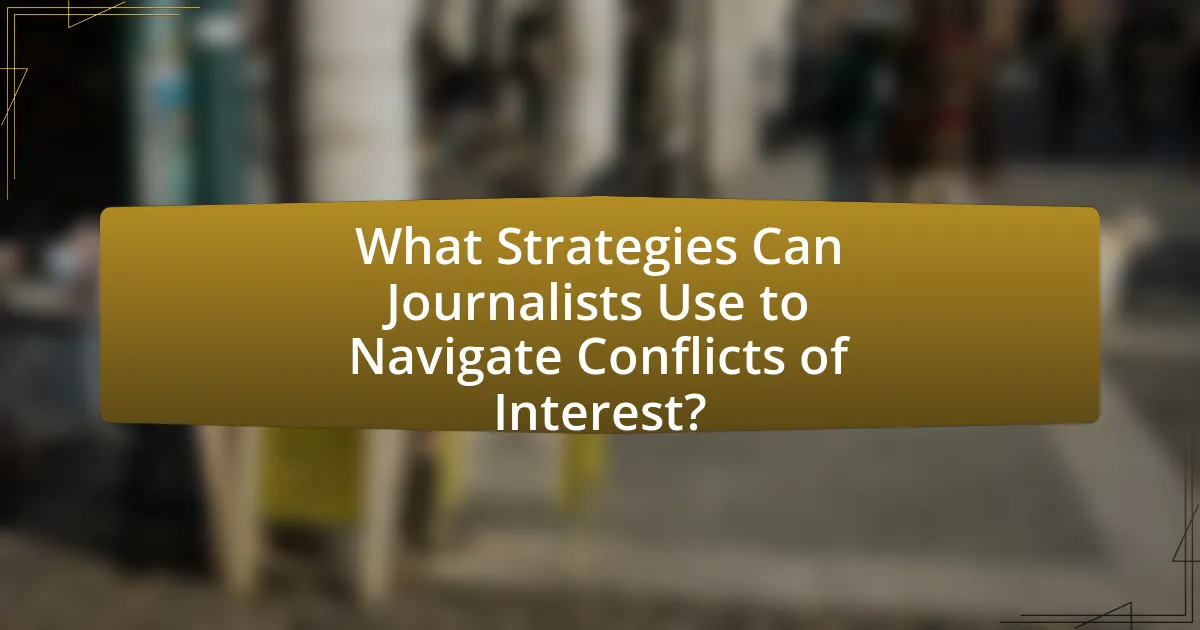Conflicts of interest in news reporting occur when journalists or media organizations have personal or financial interests that compromise their objectivity and integrity. This article explores the various sources of these conflicts, including financial relationships, personal connections, and political affiliations, and their impact on journalistic credibility and public trust. It also discusses ethical guidelines for managing conflicts, the importance of transparency, and best practices for journalists to maintain objectivity and ensure balanced coverage. By examining these aspects, the article highlights the significance of navigating conflicts of interest to uphold the integrity of journalism.

What are Conflicts of Interest in News Reporting?
Conflicts of interest in news reporting occur when journalists or media organizations have personal or financial interests that could compromise their objectivity and integrity in reporting. These conflicts can arise from relationships with sources, financial ties to businesses, or affiliations with political entities, leading to biased reporting or the omission of critical information. For instance, a journalist who owns stock in a company they are covering may inadvertently favor that company’s interests in their reporting, undermining public trust and the credibility of the news outlet.
How do conflicts of interest arise in journalism?
Conflicts of interest in journalism arise when a journalist’s personal interests or relationships compromise their objectivity and impartiality in reporting. These conflicts can occur due to financial ties, such as receiving payments from sources or advertisers, or personal connections, such as friendships or family relationships with individuals being reported on. For instance, a journalist covering a political campaign may face a conflict if they have a close relationship with a candidate, potentially biasing their coverage. Additionally, ownership structures of media organizations can create conflicts if the interests of owners influence editorial decisions, leading to biased reporting.
What are common sources of conflicts of interest for journalists?
Common sources of conflicts of interest for journalists include financial relationships, personal connections, and political affiliations. Financial relationships can arise when journalists receive payments or gifts from sources, which may bias their reporting. Personal connections, such as friendships or family ties with individuals involved in a story, can compromise objectivity. Political affiliations may lead journalists to favor certain viewpoints, affecting their impartiality. These factors can undermine the credibility of journalism, as highlighted by the Society of Professional Journalists’ Code of Ethics, which emphasizes the importance of avoiding conflicts of interest to maintain public trust.
How do personal relationships influence reporting integrity?
Personal relationships can significantly compromise reporting integrity by introducing biases that affect objectivity. When journalists have personal connections with sources, they may prioritize those relationships over factual accuracy, leading to selective reporting or the omission of critical information. Research indicates that journalists who maintain close ties with their sources are more likely to experience conflicts of interest, which can distort the truth and mislead the audience. For instance, a study published in the Journal of Mass Media Ethics highlights that personal relationships can create a perception of favoritism, ultimately undermining public trust in the media.
Why are conflicts of interest significant in news reporting?
Conflicts of interest are significant in news reporting because they can compromise journalistic integrity and objectivity. When journalists or media organizations have personal, financial, or professional ties that may influence their reporting, the credibility of the information presented can be undermined. For instance, a study by the Pew Research Center found that 62% of Americans believe that news organizations are influenced by their owners’ political views, highlighting public concern over bias stemming from conflicts of interest. This perception can erode trust in the media, making it essential for news outlets to disclose any potential conflicts to maintain transparency and uphold ethical standards in journalism.
What impact do conflicts of interest have on public trust?
Conflicts of interest significantly undermine public trust. When individuals or organizations prioritize personal gain over ethical standards, it leads to skepticism about their motives and the information they provide. Research indicates that 70% of the public believes that conflicts of interest in journalism compromise the integrity of news reporting, resulting in diminished credibility for media outlets. This erosion of trust can lead to decreased audience engagement and a reluctance to accept information from sources perceived as biased or self-serving.
How can conflicts of interest affect news coverage quality?
Conflicts of interest can significantly compromise the quality of news coverage by introducing bias and undermining journalistic integrity. When journalists or media organizations have financial, personal, or political stakes in the subjects they report on, their objectivity may be compromised, leading to skewed narratives. For instance, a study by the Pew Research Center found that 62% of Americans believe that news organizations are influenced by their owners’ political views, which can result in selective reporting and a lack of diverse perspectives. This bias not only misinforms the public but also erodes trust in the media, ultimately diminishing the overall quality of news coverage.
What ethical guidelines exist to manage conflicts of interest?
Ethical guidelines to manage conflicts of interest in news reporting include transparency, disclosure, and adherence to professional standards. Transparency requires journalists to openly communicate any potential conflicts that may influence their reporting. Disclosure involves informing audiences about relationships or financial interests that could affect the credibility of the news. Adherence to professional standards, such as those set by organizations like the Society of Professional Journalists, emphasizes the importance of integrity and accountability in reporting. These guidelines help maintain public trust and ensure that news coverage remains fair and unbiased.
What role do journalistic codes of ethics play?
Journalistic codes of ethics serve as essential guidelines that help journalists navigate conflicts of interest and maintain integrity in reporting. These codes establish standards for accuracy, fairness, and accountability, ensuring that journalists prioritize the public interest over personal or organizational biases. For instance, the Society of Professional Journalists’ Code of Ethics emphasizes the importance of seeking truth and reporting it, which directly addresses potential conflicts by encouraging transparency and honesty in the reporting process. By adhering to these ethical standards, journalists can foster trust with their audience and uphold the credibility of the news industry.
How can news organizations implement conflict of interest policies?
News organizations can implement conflict of interest policies by establishing clear guidelines that define what constitutes a conflict and outlining procedures for disclosure and management. These policies should include mandatory training for all staff on recognizing and reporting potential conflicts, as well as regular audits to ensure compliance. For instance, the Society of Professional Journalists emphasizes the importance of transparency and accountability in its Code of Ethics, which serves as a foundational reference for news organizations. By adopting such frameworks, organizations can mitigate risks associated with conflicts of interest and maintain public trust.

How can Journalists Identify Conflicts of Interest?
Journalists can identify conflicts of interest by conducting thorough disclosures of personal, financial, and professional relationships that may influence their reporting. This process involves reviewing their affiliations, investments, and any potential biases that could affect their objectivity. For instance, the Society of Professional Journalists emphasizes the importance of transparency in disclosing any relationships that could be perceived as conflicts, thereby ensuring accountability and trust in journalism.
What steps should journalists take to recognize potential conflicts?
Journalists should conduct thorough research and self-assessments to recognize potential conflicts of interest. This involves identifying personal relationships, financial interests, or affiliations that may influence their reporting. For instance, a journalist should disclose any connections to subjects they cover, as transparency is crucial in maintaining credibility. Additionally, reviewing organizational policies on conflicts of interest can provide guidelines for ethical reporting. According to the Society of Professional Journalists, understanding and disclosing conflicts helps uphold journalistic integrity and public trust.
How can self-reflection help in identifying personal biases?
Self-reflection aids in identifying personal biases by allowing individuals to critically examine their thoughts, beliefs, and reactions. This introspective process encourages awareness of preconceived notions and emotional responses that may influence decision-making and reporting. Research indicates that self-reflection can enhance cognitive flexibility, enabling individuals to recognize and challenge their biases, ultimately leading to more balanced and objective perspectives in news reporting. For instance, a study published in the Journal of Personality and Social Psychology found that individuals who engaged in self-reflection were more likely to acknowledge their biases and adjust their viewpoints accordingly.
What tools or resources are available for conflict identification?
Tools and resources available for conflict identification in news reporting include conflict of interest checklists, transparency guidelines, and software for tracking relationships and financial interests. Conflict of interest checklists help journalists assess potential biases by evaluating personal, financial, or professional connections that may influence reporting. Transparency guidelines, such as those provided by the Society of Professional Journalists, outline ethical standards for disclosing conflicts. Additionally, software tools like Media Bias/Fact Check and NewsGuard assist in evaluating the credibility of sources and identifying potential conflicts in reporting. These resources are essential for maintaining journalistic integrity and ensuring accurate reporting.
How can transparency mitigate conflicts of interest?
Transparency can mitigate conflicts of interest by ensuring that all stakeholders are aware of potential biases and influences affecting decision-making. When organizations disclose relationships, financial interests, and affiliations, it allows audiences to critically assess the credibility of the information presented. For instance, a study by the Pew Research Center found that transparency in reporting practices increases public trust, as audiences feel more informed about the motivations behind the news. By fostering an environment of openness, transparency reduces the likelihood of hidden agendas influencing reporting, thereby promoting ethical journalism.
What are the best practices for disclosing conflicts to the audience?
The best practices for disclosing conflicts to the audience include transparency, clarity, and timeliness. Transparency involves openly acknowledging any potential conflicts of interest that may influence reporting, ensuring that the audience is aware of the journalist’s affiliations or financial interests. Clarity requires that disclosures be straightforward and easily understood, avoiding jargon that could confuse the audience. Timeliness means that disclosures should be made as soon as a conflict is identified, ideally at the beginning of a report or article, to maintain trust and credibility. Research indicates that audiences are more likely to trust news sources that are upfront about conflicts, as demonstrated in a study by the Pew Research Center, which found that transparency in reporting enhances audience perception of credibility.
How does transparency enhance journalistic credibility?
Transparency enhances journalistic credibility by allowing audiences to understand the sources, methods, and potential biases behind news reporting. When journalists disclose their sources and the processes they use to gather information, it fosters trust and accountability. For instance, a study by the Pew Research Center found that 70% of Americans believe that transparency about sources is essential for credible journalism. This level of openness helps mitigate perceived conflicts of interest, as audiences can better assess the reliability of the information presented.

What Strategies Can Journalists Use to Navigate Conflicts of Interest?
Journalists can navigate conflicts of interest by implementing transparency, establishing clear ethical guidelines, and seeking external oversight. Transparency involves disclosing any potential conflicts to the audience, which builds trust and accountability. Establishing ethical guidelines, such as those provided by professional organizations like the Society of Professional Journalists, helps journalists make informed decisions about their reporting. Seeking external oversight, such as editorial review or consultation with ethics boards, can provide additional perspectives and reinforce ethical standards. These strategies are supported by research indicating that transparency and adherence to ethical guidelines significantly enhance public trust in journalism.
How can journalists maintain objectivity in their reporting?
Journalists can maintain objectivity in their reporting by adhering to established ethical guidelines and employing fact-checking practices. Ethical guidelines, such as those outlined by the Society of Professional Journalists, emphasize the importance of seeking truth, minimizing harm, and acting independently. By rigorously fact-checking information before publication, journalists can ensure accuracy and reduce bias. Studies have shown that adherence to these principles leads to higher credibility and trust among audiences, reinforcing the necessity of objectivity in news reporting.
What techniques can be employed to ensure balanced coverage?
To ensure balanced coverage in news reporting, journalists can employ techniques such as diverse sourcing, fact-checking, and presenting multiple viewpoints. Diverse sourcing involves gathering information from a wide range of stakeholders, which helps to represent various perspectives and reduces bias. Fact-checking ensures that the information presented is accurate and reliable, thereby maintaining credibility. Presenting multiple viewpoints allows audiences to understand different sides of an issue, fostering a more comprehensive understanding. These techniques are supported by research indicating that balanced reporting enhances public trust and engagement in media, as evidenced by studies from the Pew Research Center, which highlight the importance of diverse perspectives in news coverage.
How can collaboration with editors help in conflict management?
Collaboration with editors can significantly enhance conflict management by ensuring that diverse perspectives are considered and that editorial decisions are made transparently. Editors play a crucial role in mediating between conflicting viewpoints, facilitating discussions that lead to balanced reporting. For instance, a study by the Pew Research Center found that news organizations that prioritize editorial collaboration are more effective in addressing biases and conflicts of interest, resulting in higher credibility among audiences. This collaborative approach allows for the identification of potential conflicts early in the reporting process, enabling journalists to address them proactively and maintain journalistic integrity.
What are the best practices for reporting in the face of conflicts?
The best practices for reporting in the face of conflicts include transparency, impartiality, and adherence to ethical guidelines. Journalists should disclose any potential conflicts of interest to maintain credibility and trust with their audience. For instance, the Society of Professional Journalists emphasizes the importance of avoiding conflicts that could compromise integrity, which is crucial for accurate reporting. Additionally, journalists should strive to present multiple viewpoints to ensure balanced coverage, as this approach fosters a more comprehensive understanding of the issue at hand. Following these practices helps uphold journalistic standards and protects the integrity of the reporting process.
How can journalists effectively communicate potential conflicts to their audience?
Journalists can effectively communicate potential conflicts to their audience by clearly disclosing any relevant affiliations or interests that may influence their reporting. This transparency allows the audience to critically assess the information presented and understand any biases that may exist. For instance, the Society of Professional Journalists emphasizes the importance of transparency in ethical journalism, stating that journalists should “avoid conflicts of interest” and “disclose unavoidable conflicts.” By adhering to these ethical guidelines, journalists foster trust and credibility with their audience, enabling informed consumption of news.
What role does ongoing training play in conflict navigation?
Ongoing training plays a crucial role in conflict navigation by equipping individuals with the skills and knowledge necessary to identify, address, and resolve conflicts effectively. This training enhances communication abilities, fosters emotional intelligence, and promotes understanding of diverse perspectives, which are essential for navigating conflicts in news reporting. Research indicates that organizations that invest in ongoing conflict resolution training experience a 30% reduction in workplace disputes, demonstrating the tangible benefits of such training in improving conflict management outcomes.
What practical tips can journalists follow to avoid conflicts of interest?
Journalists can avoid conflicts of interest by adhering to strict ethical guidelines and maintaining transparency in their reporting. They should disclose any personal relationships or financial interests that may influence their work, ensuring that audiences are aware of potential biases. Additionally, journalists must refrain from accepting gifts or favors from sources, as this can compromise their objectivity. Regular training on ethical standards and conflict of interest policies can further reinforce these practices. Research indicates that adherence to ethical guidelines significantly enhances public trust in journalism, as seen in studies conducted by the Pew Research Center, which highlight the importance of transparency in media credibility.

Leave a Reply